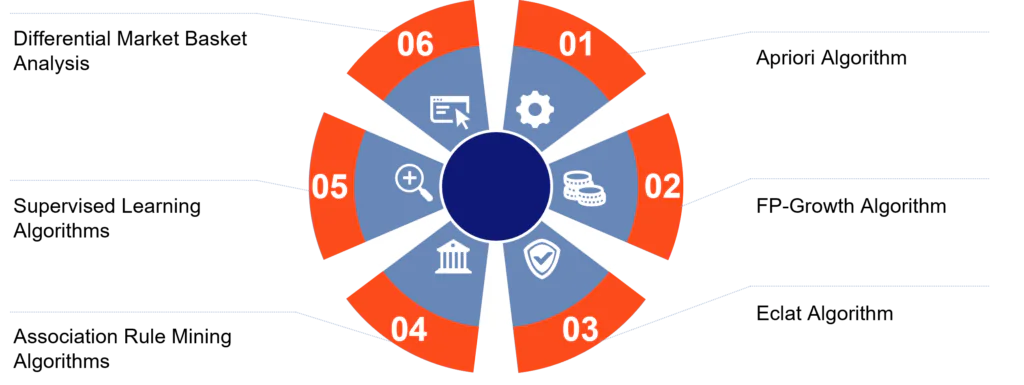Author Details: Associate Vice President, Analytics and Data Strategy, Quantzig.
Table of Contents
Introduction to Market Basket Analysis in Retail
The current scenario in the retail industry is characterized by its highly customer-centric nature. Retailers are leaving no stone unturned to discover new ways of getting to know their customers better. Market basket analysis is one such tool that has caught the eye of several retail companies. With the help of this tool, not only can retailers identify target markets, but they can also enhance their customer-base by creating, delivering, and communicating a superior customer experience. But that is not all; in this article, we will discuss the key benefits of market basket analysis for retailers.
Book a demo to experience the meaningful insights we derive from data through our analytical tools and platform capabilities. Schedule a demo today!
Request a Free DemoWhat is Market Basket Analysis?
Market basket analysis (MBA) is essential for retail analytics, as it helps retailers monetize customer behavior through customer behavior analysis. By analyzing customer purchasing patterns, market basket data analysis allows retailers to predict buying decisions and understand the dynamics of shopping basket analysis. Utilizing association rule mining in retail, product affinity analysis, and cross-selling analysis in retail, market basket analysis for retail identifies opportunities for increased sales. Furthermore, retail market basket analysis employs various market basket analysis techniques to explore “what-if” scenarios regarding assortment changes. This process supports basket optimization in retail and enhances overall retail sales analysis, driving effective strategies in market basket analytics and market basket research in retail.
Types of Market Basket Analysis
| Types | Description |
|---|---|
| Descriptive MBA | Identifies and summarizes patterns and associations in historical data to understand customer purchasing behaviors. |
| Predictive MBA | Uses historical purchasing data to predict future buying patterns and customer behaviors. |
| Prescriptive MBA | Recommends actions and strategies to optimize product placement, pricing, and promotions based on purchasing pattern analysis. |
| Cross-Selling MBA | Analyzes data to identify opportunities for selling additional products to existing customers based on their purchase history. |
| Affinity Analysis | Determines the relationships and correlations between different products purchased together frequently. |
| Sequential Pattern Analysis | Examines the order in which products are purchased to understand and predict sequences of purchases. |
| Real-Time MBA | Applies analysis techniques to real-time data to make immediate recommendations for marketing and sales strategies. |
Algorithms Used in Market Basket Analysis

The key algorithms used in Market Basket Analysis include:
- Apriori Algorithm: The most commonly used algorithm for market basket analysis. It identifies frequent itemset and generates association rules based on user-defined minimum support and confidence thresholds.
- FP-Growth Algorithm: An efficient alternative to the Apriori algorithm, the FP-Growth algorithm constructs a compact data structure called an FP-Tree to store crucial information about frequent itemset, avoiding the costly candidate generation step.
- Eclat Algorithm: A depth-first search algorithm that uses a vertical data format to efficiently discover frequent itemset. It is particularly effective for sparse datasets.
- Association Rule Mining Algorithms: Algorithms such as AIS, SETM, and Generalized Rule Induction that utilize association rule mining techniques to uncover relationships between purchased items.
- Supervised Learning Algorithms: Techniques like regression and classification can be employed for predictive market basket analysis, modeling the likelihood of sequential purchases.
- Differential Market Basket Analysis: Algorithms that compare purchasing patterns across different segments, time periods, or competitive environments to identify unique behavioral insights.
The choice of algorithm often depends on factors such as the size and sparsity of the dataset, the desired level of granularity in the analysis, and the specific business objectives driving the market basket analysis.
What are the Applications of Market Basket Analysis?
Market basket analysis (MBA) is a powerful tool that helps organizations across various industries unlock valuable insights from transaction data. By examining purchasing patterns and consumer behavior, MBA enables data-driven decision-making, enhances operational efficiency, and optimizes customer experiences. From retail to telecommunications and banking, leveraging market basket analytics uncovers hidden associations, personalizes offerings, and detects anomalies, ultimately driving profitability and customer satisfaction.
Market basket analysis has diverse applications across various industries, leveraging market basket analytics to enhance decision-making:
Retail
- Utilize basket analysis in retail to identify product combinations frequently purchased together, optimizing product placement and promotions.
- Personalize product recommendations based on customer purchasing patterns analysis and purchase history.
- Employ market basket data analysis to detect fraudulent transactions by recognizing unusual purchasing patterns.
Telecommunications
- Analyze customer churn through cross-selling analysis in retail, identifying services frequently purchased together.
- Determine optimal pricing for service bundles using insights from retail sales analysis based on purchasing patterns.
Banking and Finance
- Build customer profiles for credit card fraud detection through consumer basket analysis in retail.
- Identify cross-selling opportunities based on transaction data using data mining in retail techniques.
Insurance
- Detect fraudulent insurance claims by analyzing claim patterns through market basket research in retail.
- Identify comorbid conditions and symptom associations in healthcare data via product affinity analysis.
E-Commerce
- Power recommendation engines using market basket analysis for retail to suggest complementary products to customers.
- Optimize product placements and content recommendations through association rule mining in retail and basket optimization in retail.
Manufacturing
- Predict equipment breakdowns by analyzing sensor data and maintenance records through market basket analysis techniques.
Pharmaceuticals
- Discover associations between diagnoses and drug prescriptions using shopping basket analysis.
- Identify patient subgroups with similar treatment patterns through customer behavior analysis.
In summary, market basket analysis empowers data-driven decision-making across various industries by uncovering hidden relationships and patterns in transaction data, enabling effective market basket analysis applications.
How Does Market Basket Analysis Work?
Market basket analysis (MBA) is an essential technique in retail analytics, allowing businesses to uncover valuable insights from transaction data. By leveraging market basket data analysis, organizations can examine large datasets of customer transactions, such as point-of-sale data and e-commerce orders, to identify purchasing patterns that drive sales and enhance customer experiences.
Key Components of Market Basket Analysis
- Data Analysis: MBA analyzes extensive datasets of customer transactions, including consumer basket analysis in retail and e-commerce orders.
- Frequent Itemsets: It identifies frequent itemsets—groups of products that are commonly purchased together, utilizing market basket analytics.
- Algorithms: Algorithms like Apriori, FP-Growth, and Eclat are employed to discover these associations, exemplifying market basket analysis techniques.
- Key Metrics: MBA calculates essential metrics such as support, confidence, and lift to measure the strength of product associations:
- Support: Measures how frequently an itemset appears in the dataset, a fundamental aspect of shopping basket analysis.
- Confidence: Assesses the conditional probability of purchasing one item given that another item is bought, aiding in cross-selling analysis in retail.
- Lift: Indicates how much the purchase of one item increases the likelihood of purchasing another, enhancing product affinity analysis.
- Association Rules: MBA generates association rules in the form of “if-then” statements (e.g., if a customer buys bread, then they are likely to also buy butter), supporting data mining in retail.
- Retail Application: Retailers can leverage these insights to optimize product placement, create targeted promotions, and make personalized recommendations, ultimately enhancing retail sales analysis.
The primary goal of market basket analysis is to uncover hidden relationships in customer purchasing behavior, driving increased sales, customer satisfaction, and profitability. By utilizing comprehensive techniques like retail market basket analysis and basket optimization in retail, organizations can make informed decisions that significantly impact their bottom line and customer engagement, ensuring they remain competitive in the market.
What are the Key Benefits of Market Basket Analysis in Retail?
Market basket analysis (MBA) offers significant advantages for retailers seeking to enhance their operations and customer engagement. By examining purchasing patterns and consumer behavior, MBA enables retailers to uncover hidden relationships between products, optimize inventory management, and tailor marketing strategies. This analytical approach not only supports targeted promotions and personalized recommendations but also improves overall sales performance and customer satisfaction. Understanding the key benefits of market basket analysis empowers retailers to make data-driven decisions that drive profitability and foster long-term customer loyalty.

Market Basket Analysis (MBA) offers several key benefits to retailers:
1. Advertising and Promotions
Modern retailers are using market basket analysis for making advertising and promotions more predictable by understanding how consumers respond to various offers and communications. For instance, this technique will help companies in the retail industry to know when and where a discount will have an impact on top-line sales and cut down on unnecessary reductions. It will give retailers a clearer picture of whether their promotional activities are merely shifting revenue around or if it is genuinely contributing to boosting the gross sales.
2. Precise Targeting and Improved ROI
By understanding what exactly their customers need, retailers can easily engage in specific targeting. Companies in the retail industry are using market basket analysis to optimize campaigns and promotions for with margins and sales uplift with more precise campaigns. This method will also yield good ROI as only the right customers who might be interested in the campaigns are targeted.
3. More In-Store Traffic
Retail companies can use market basket analysis to get a better understanding of what products and offers will drive more traffic to the stores. This can be done by correlating market basket analysis with foot traffic counts to understand what customers purchased when they were in the store. Once a retailer successfully identifies what initially bought the customers to the store, they can use market basket analysis to determine how to make their customers come back to the store next time.
4. Optimized Store Layout
Players in the retail industry can use market basket assessments to enhance their space planning and visual merchandising, consequently ensuring better efforts to cross-sell and up-sell. For example, it will help retailers identify if end caps in the retail store are helping to drive more sales. In case they are, it can be analyzed if they are also driving sales of complementary products. This will help retailers to better plan their store layout and make the necessary changes.
5. Enhanced Customer Understanding
MBA provides valuable insights into customer behavior, including which products are frequently purchased together and which items are most popular. This understanding enables retailers to make informed decisions to better serve their customers.
6. Optimized Inventory Management
By analyzing market basket data, retailers can identify slow-moving products and determine which items are commonly bought together. This knowledge helps retailers make data-driven decisions about product assortment and inventory levels, reducing costs and improving profitability.
7. Personalized Recommendations
MBA allows retailers to leverage recommendation engines to suggest relevant products to customers based on their purchase history and preferences. This personalized approach stimulates demand, facilitates cross-selling opportunities, and enhances the overall customer experience.
In summary, Market Basket Analysis is a powerful tool that enables retailers to gain valuable insights into customer behavior, optimize operations, and implement targeted strategies to enhance the customer experience and drive revenue growth.
Experience the advantages firsthand by testing a customized complimentary pilot designed to address your specific requirements. Pilot studies are non-committal in nature.
Request a Free PilotOther Purposes of Using Market Basket Analysis
Market Basket Analysis (MBA) Can Be Applied Across Various Domains
While widely recognized as a retail strategy, Market Basket Analysis (MBA) extends its applicability to multiple other areas:
- Predictive Maintenance: Utilizing predictive analysis to foresee equipment breakdowns in the manufacturing sector.
- Pharmaceutical/Bioinformatics: Identifying co-occurrence patterns between diagnoses and pharmaceutical active ingredients administered to different patient groups.
- Financial Criminology: Analyzing credit card usage data to detect and prevent fraudulent activities.
Get started with your complimentary trial today and delve into our platform without any obligations. Explore our wide range of customized, consumption driven analytical solutions services built across the analytical maturity levels.
Start your Free TrialConclusion
Market Basket Analysis (MBA) is transformative for the retail industry, leveraging machine learning and AI (Artificial Intelligence) to decode customer purchasing patterns. The insights derived enable retailers to monetize customer behavior through targeted market campaigns, cross-selling strategies, and product recommendation systems. By providing a detailed Market Basket Analysis, MBA aids in predictive analysis and decision-making, driving increased sales and customer satisfaction. The integration of MBA in Retail & CPG Analytics showcases its potential to optimize inventory, enhance customer experience, and significantly boost profitability.







